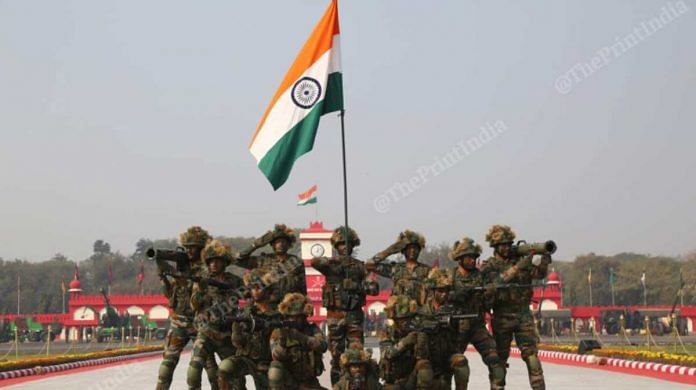The PM was also quoted as saying that the Armed Forces have “complete operational freedom to decide on the mode, targets and timing of our response”.
The die is cast for military action against Pakistan. The only questions now are when, how, and at what scale— decisions left to the Armed Forces. Naivety of the “official sources” regarding “freedom of action”, notwithstanding, I have no doubts that the PM has also formally conveyed his political aim to the military leadership along with any political limitations imposed with respect to timing, duration and scale of operations. Surprisingly, the formal strategic decision making has been done overtly ending the adversary’s dilemma of uncertainty.
The political aim of a war or any military action below its threshold against Pakistan is to prevent it from perpetrating a terrorism driven proxy war in Jammu and Kashmir and any similar action anywhere in the hinterland.
In deciding how to achieve this aim, successive Prime Ministers have faced a dilemma: whether to accept the economic and military cost of a war to fully reimpose offensive deterrence or to handle the situation through limited actions, carefully controlling the escalation. Uncertainty of outcome and the apprehension of politically damaging setbacks further compound this dilemma.
It is pertinent to mention that in the last 35 years, since the beginning of the proxy war in J&K, military action short of war has not deterred Pakistan. These actions have varied from firefights, assaults, small-scale covert raids along the Line of Control to declared surgical Special Forces/Indian Air Force strikes in 2016 and 2019 under PM Modi. In the upper end of the spectrum of conflict, a limited war (limited in space) was fought in Kargil in 1999, and a full-scale coercive deployment was carried out for one year in 2002.
In view of the above, the scale of the response is always a political decision. At this juncture, how the Armed Forces will achieve the political aim set out by the Prime Minister is a matter of speculation.
India does not have a national security strategy, and the contingent national defence policy required to create and maintain the capacity and capability to execute the same. Traditionally, India followed a military strategy of ‘strategic defence’ wherein war was not initiated and the adversary’s offensive was absorbed, and then a counter-offensive was launched.
In 1986, General Krishnaswamy Sundarji wrote a vision paper with a 15-year perspective——virtually spelling out the contours of national security strategy, defence policy, and military strategy. He personally signed the document—the first, and so far, the last time by any service Chief. It was decided to create, maintain, and, when necessary, impose a ‘dissuasive deterrent’ against China and an ‘offensive deterrent’ against Pakistan. This was also accepted by the Indian Air Force and the Indian Navy.
By implication, it meant that China would be deterred defensively by making its military actions prohibitively costly in terms of men and material, and Pakistan would be punished by seizing maximum territory and destruction of its military machine and economic potential. As a matter of fact, he did in 1986-87 against both adversaries by aggressive deployment but remained short of a hot war due to political indecisiveness. Despite the nuclear backdrop and enhanced military potential of all players, this strategy, duly modified, continues to be in vogue. Defence Minister’s , which currently guides the military, is broadly based on this military strategy.
This ‘dissuasive deterrent’ has been eminently successful against China, which conventionally threatens our territorial integrity—except when we have been surprised in un-held territory, as in April-May 2020, resulting in the loss of control over 1000 square km. However, the deterrent was reimposed with our massive deployment and aggressive posture on the Kailash Range. Despite the huge military differential in China’s favour, a face-saving compromise was reached in October 2024, after a tense standoff of three and a half years.
Since 1971, Pakistan has not posed any direct conventional threat to India. With effect from 1989, it has waged a fourth-generation proxy war predominantly fought by its ‘disowned’ citizens and supported by coreligionists in J&K. However, the execution or reimposition of the deterrent against the proxy war in J&K and periodically in the hinterland since 1993 has posed a strategic dilemma.
Pakistan has selectively upgraded its forces to operate below the threshold of war and can evenly match India’s actions in this space. However, it remains most worried about India’s numerical superiority in a limited war below the nuclear threshold.
At this juncture, the window of a limited war based on the proactive strategy to capture maximum territory, particularly in J&K, and destroy Pakistan’s economic and military potential using the IAF and the Navy, has been closed. This was contingent on an early political decision achieving surprise with a rapid mounting tempo before the adversary was ready and should have been well underway by now.
But the element of surprise has been lost, and Pakistan has mobilised its armed forces. Any major offensive now would become a slogging match. This option now exists only as a preemptive strike, relying on strategic surprise in a longer time frame. Another factor is the possibility of direct collusive support from China in the campaigning season along the northern borders, which lasts until the end of November—to tie down Indian formations. Meanwhile, Chinese non-kinetic support in the form of deniable cyber and electronic warfare, along with strategic intelligence, is omnipresent.
Consequently, the immediate aim would be restricted to a punitive action with carefully managed escalation to assuage public emotions. This can take the form of a combination of air, missile, drone, or Special Forces strikes and activation of the LoC with fire assaults with precision-guided munitions (PGM). It may include the capture of some posts across the LoC. Even a small incision in Pakistan’s “shah rag or jugular vein” will hurt it the most. Pakistan can respond in a quid pro quo manner to all these actions. It will be a fairly even skirmish, and the side with better technology and tactics will have the advantage.
Pakistan is reeling under the onslaught of homegrown terrorism in Balochistan and Khyber Pakhtunkhwa. It holds India responsible for this through its proxies – Taliban (Afghanistan), Tehrik-e-Taliban Pakistan, and Baloch terrorist organisations. The , in which a large number of soldiers and their families were killed, was a big setback for the Pakistan Army. The perceived targeting of Lashkar-e-Taiba and Jaish-e-Mohammed leadership by India is also a big embarrassment for Pakistan’s Inter-Services Intelligence.
In my view, the Baisaran terrorist attack was a deliberately planned operation to seek revenge and, more than that, to provoke and lure India into taking a hasty military action. Based on past experience, Islamabad assumes that the response would be below the threshold of war. Keeping this in view, it is prepared to not only neutralise India’s actions but retaliate with a much higher-scale response. This would put the onus on India to further escalate from a position of disadvantage in terms of surprise.
It may be prudent to keep Pakistan on tenterhooks for a prolonged period. Let it “cry wolf” until the day of reckoning, which must come like a thunderbolt.








